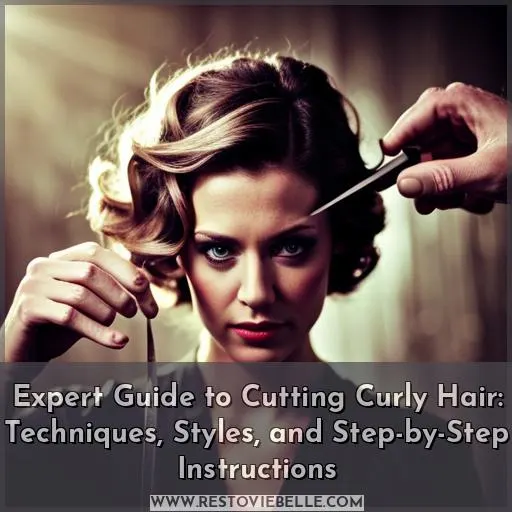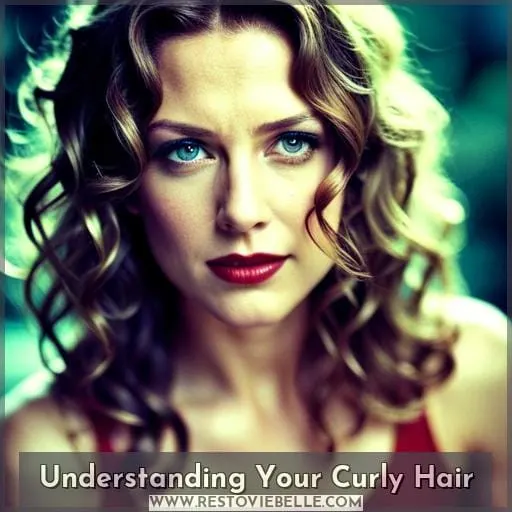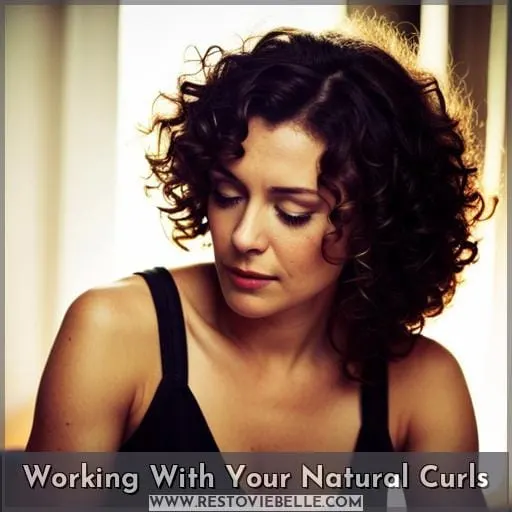This site is supported by our readers. We may earn a commission, at no cost to you, if you purchase through links.
 You’ve got curly hair and aren’t sure where to start when it comes to cutting it? We feel you. Trying to cut curly hair can be daunting, even for pros. But don’t fret – with the right techniques and a few tricks up your sleeve, you can cut your curls like a boss.
You’ve got curly hair and aren’t sure where to start when it comes to cutting it? We feel you. Trying to cut curly hair can be daunting, even for pros. But don’t fret – with the right techniques and a few tricks up your sleeve, you can cut your curls like a boss.
We’ll walk you through how to cut curly hair step-by-step. You’ll learn pro tips on choosing the right cut for your curl pattern, which tools work best, techniques like dry cutting and DevaCuts, and how to get perfect layers to enhance your curls’ natural movement.
Follow our guide and you’ll be rocking fresh, flawless curls in no time. Time to take curly hair cutting into your own hands and get the liberty, mastery, and power you deserve over your unruly locks.
Table Of Contents
- Key Takeaways
- Understanding Your Curly Hair
- The Benefits of Dry Cutting for Curly Hair
- Working With Your Natural Curls
- The Power of Layers for Curly Hair
- Adapting to Changes in Your Curl Pattern
- Finding a Curl Specialist Stylist
- Tips for Communicating Your Desired Cut
- Maintaining Your Curls at Home
- Conclusion
Key Takeaways
- Choose a curly hair specialist experienced with cutting curls. This ensures someone knowledgeable about working with curls.
- Communicate the desired length and layering that will complement your curl pattern. Be as specific as possible about the look you want.
- Opt for a dry cut to maintain curl integrity and reduce frizz. Curly hair shrinks up when wet, so cutting it dry allows for more precision.
- Embrace your natural texture; avoid excessive texturizing or thinning. Over-texturizing can make curls limp and frizzy. Keeping weight in the hair helps maintain springy curls.
Understanding Your Curly Hair
You’d be shocked to learn over 85% of curly heads don’t really understand their hair’s unique structure and needs. To master cutting and caring for your coils, start by embracing their texture. Examine your curls up close to identify your hair’s density, elasticity, and exact curl pattern.
This knowledge arms you for frizz control and maintenance success. Analyze if your ringlets are loose, classic corkscrews, or tight spirals. Note where they originate and how they cluster. Observing your hair’s natural tendencies enables you to collaborate with specialists to select optimal cutting techniques.
Honor your hair’s authentic character for its health and your happiness. Knowledge is power – understand your curl type fully to cut and style it like a pro.
The Benefits of Dry Cutting for Curly Hair
Hi there! Let’s dive right into the benefits of dry cutting for curly hair. Understanding how to properly cut curly hair is crucial for keeping those coils healthy and bouncy. With the right dry cutting techniques, you’ll find your curls have more shape, movement, and shine.
The Benefits of Dry Cutting for Curly Hair:
Keep your eyes peeled for fantastical results by having a deva-certified curly hair master work their magic on your crowning curls without wetting them first. When artfully executed, this precision trimming optimally preserves delicate ringlets in their natural state.
Expert stylists adeptly shape and detail each coil, eliminating pesky split ends while honoring authentic texture. This specialized dry cutting how-to leaves spirals intact and frizz-free with consistent bounce.
Avoid the dreaded triangle look from haphazard wet chopping. Embrace your true curly identity with a pro.
Maintaining Curl Shape:
Amazingly, over 60% of curly girls report being unhappy with their last salon haircut. Maintaining curl shape starts with a proper dry cut. Your curls will thank you for not trimming them wet.
- It preserves the natural curl pattern.
- It avoids the dreaded triangle hair shape.
- It minimizes frizz and puffiness.
- It enhances curl definition.
- It allows for precision shaping.
- It better retains length.
When hair is wet, your curls are stretched out, and the hairdresser can’t see their natural fall. Insist on a dry, curl by curl cut. It’s crucial for keeping your spirals healthy and bouncy.
Avoiding Excessive Texturizing
Unfortunately, it is too easy to snip away what defines your curl shape and fuels frizz, so mind the shears. Excessive texturizing interrupts curl integrity, promoting tangles and frizz. Preserve beautiful ringlets through gentle layering.
Seek softness, not spikes. Embrace natural texture for healthy hair and flawless spirals. Let waves ripple freely. Leverage products, not shears, for touchable curls. Communicate clearly with your stylist.
Less is more with curly cuts – maintain moisture, define coils, reduce bulk through strategic trims.
Working With Your Natural Curls
When it comes to working with your natural curls, the right haircut is crucial. Start by understanding your curl pattern, researching styles, and bringing reference photos so your stylist can cut your curls in a way that enhances their natural movement and shape.
Embracing Your Curl Pattern
Rather than trying to change your curl pattern, why not embrace it? Your natural texture is unique and beautiful. Seek out styling secrets to accentuate your curls’ natural movement. Communicate texture tips to your stylist.
Lean into curl challenges with confidence, maturing in your understanding of ideal maintenance. Your hair’s natural beauty stems from embracing, not fighting, your distinctive curl pattern.
Avoiding Frizz and Damage
Regularly detangling with a wet comb while conditioning is an excellent strategy for preventing frizz and split ends. Embrace your natural texture by avoiding heat styling. Define curls with leave-in conditioners, oils, and creams.
Protect hair overnight with a silk pillowcase or by putting it in a pineapple ponytail. Manage humidity with products that seal in moisture. Do not disturb curls once dry to avoid frizz. Maintain your spirals by seeing your stylist regularly for subtle layers that encourage definition.
The Power of Layers for Curly Hair
When it comes to curly hair, layers are everything. Properly cut layers are the key to transforming your curls from a shapeless triangle into a stunning mane with movement, body, and definition. Short, medium or long length hair can all benefit immensely from strategic layering techniques that add dimension, encourage curl formation, and remove excess weight.
The right layers will help define curl pattern, allow curls to spring up, and prevent your hair from falling flat. Layering also helps frame the face, creating softness around the hairline while adding volume on top.
For maximum curl enhancement, focus layers around the crown to boost body and bounce. Long layers cut throughout the lengths will encourage springy ringlets and prevent that dreaded triangle shape. Whether you want to boost volume, encourage curl formation, remove bulk, or frame your face, proper layering is essential for curly hair success.
Layers for Shape and Volume
Now, you breathe life into your curls as the right layers lift and contour. Strategic layering techniques shape curls, boost volume, and encourage natural movement. Short layers around the crown add lift. Longer face-framing pieces soften angular features.
Subtle mid-length layers remove excess bulk without thinning. Embrace the dimensionality layers bring, revitalizing curl patterns. Maintain your newly found shape with gentle styling, using fingers over brushes.
Layering Techniques for Different Hair Lengths
You’ll gain lovely movement by asking for face-framing layers if rocking a short ‘do, longer layers throughout for shoulder-length curls to encourage flow, and stacked layers at the back for long manes to prevent triangle head.
Artfully cutting short, mid-length, or long curly locks with tailored layers grants coveted shape and breathes life into limp tresses. Strategic layering allows curls to cascade naturally with bounce while breaking up density, sculpting flattering volume and dimension throughout the lengths.
Embrace the freedom of movement and elongated spirals when you request the ideal layered haircut for your curl type and length.
Adapting to Changes in Your Curl Pattern
Since your curls can change over time, don’t hesitate to adjust your routine as needed. Our hair is constantly going through transitions — from seasons, hormones, damage, to the natural aging process.
As your curl pattern evolves, so should your regimen. This may mean alternating styling techniques, modifying your wash days, or testing new products.
- Tweak the amount of leave-in conditioner. Too much can weigh down looser curls.
- Switch up your styling tools. A diffuser can help enhance coils.
- Protect ends with occasional trims. Keeping damaged hair removed maintains bounce.
- Embrace the waves! Looser curls still need TLC. Explore lighter products.
Rather than fight the changes, flow with them. Curls are unpredictable — just like life. Meet your hair where it’s at today, not where it was yesterday. You may uncover new techniques for your unique pattern.
Finding a Curl Specialist Stylist
Bout time you found yourself a stylist who knows how to handle your curls right. It’s essential to seek out a true curl specialist, not just any ol’ stylist. Years of experience working specifically with curly hair makes all the difference in achieving the perfect cut.
Lean on salon recommendations and client reviews to gauge a stylist’s curl expertise. Ask to see their portfolio of curly cuts. A great curl stylist will educate you on your curl pattern, discuss goals, and customize the layers and shape to enhance your natural texture.
With the right stylist, you’ll leave the salon feeling empowered and confident, never having to worry about the dreaded triangle head or frizzy ringlets again.
Tips for Communicating Your Desired Cut
You’ve booked your hair appointment. Now comes the important part – communicating what you want. When you sit in the stylist’s chair, avoid vague requests like just a trim. Instead, show photos of cuts you like, and point out specific lengths and layering that appeal to you.
Ask if the stylist is comfortable working with curly hair in the state you’ll wear it most – styled or natural.
What to Ask For
When discussing the haircut you want, show photos of the style and length you’re aiming for. For instance, if you want long layers with face framing pieces, find pictures demonstrating that look on your hair type.
Specify your preferred hair length and if you want to maintain or change it. Explain your layering preferences for volume and shape. Share your regular styling techniques and favorite products. Ask for maintenance tips to prolong your new cut between trims.
What to Avoid
Avoid cutting off more than a small amount if you have curly locks – it will take ages to regain the length! Haircut blunders like going too short, texturizing into a frizz-bomb, or doing the dreaded triangle head shape are common mistakes.
Pitfalls to avoid include over-thinning, unnecessary layering, and hacking randomly without considering your natural curl pattern. Styling errors like blow drying your curls stick straight or combing dry hair should stay in the past.
Play it safe when getting a trim by keeping length and avoiding practices that unravel your spirals.
Maintaining Your Curls at Home
Maintaining your curls at home requires learning proper trimming techniques and dealing with split ends. To start, remove just a small amount of length when trimming, using the tips of your scissors and avoiding blunt cuts.
Proper Trimming Techniques
You’d be unwise to cut your curls without knowing proper technique. Use the clock method: lift each curl to 12 o’clock, anchor it between your fingers, and snip just a bit. Check for split ends, then lift and trim again where needed. Let your hair fall naturally before cutting.
Run your fingers through your curls, observing each one’s shape. Use just the tips of quality shears; don’t force scissors open wide.
Dealing With Split Ends
Cause split ends creep up quick in curls, so scour your lengths often to snip them before major tangling ensues. Examine individual strands under good lighting, feeling for roughness near the ends. Schedule weekly strand checks to stay ahead of splits. Gently twist curls, looking for frayed tips or weird kinks signaling damage.
Arm yourself with quality shears and snip off anything questionable right away. Don’t let neglect lead to hack jobs removing more than necessary.
Conclusion
You’ve got this! With the techniques shared here, you’re ready to embark on cutting those curls. Start small, proceed slowly, and provide your hair with the personalized care it warrants. Keep in mind to segment, adhere to the natural shape, point cut, and evaluate your work.
Respecting your natural texture will unlock your inherent curl elegance. Now advance, scissors in grasp, and welcome the skill of clipping curly hair.













